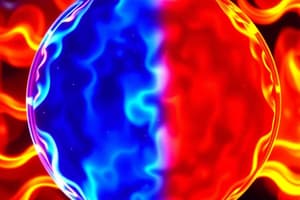Podcast
Questions and Answers
What process describes the change of a solid directly to a gas?
What process describes the change of a solid directly to a gas?
- Condensation
- Evaporation
- Sublimation (correct)
- Deposition
Which type of autotroph uses sunlight for energy to produce food?
Which type of autotroph uses sunlight for energy to produce food?
- Chemoautotrophs
- Phototrophs (correct)
- Decomposers
- Heterotrophs
What is the primary mechanism of heat transfer in fluids?
What is the primary mechanism of heat transfer in fluids?
- Induction
- Convection (correct)
- Radiation
- Conduction
How does the energy from the sun contribute to the wind?
How does the energy from the sun contribute to the wind?
What do we call the first day of summer or winter?
What do we call the first day of summer or winter?
What happens to the particles of a substance when thermal energy is added?
What happens to the particles of a substance when thermal energy is added?
What is combustion?
What is combustion?
Which process describes the transition of a substance from gas to liquid?
Which process describes the transition of a substance from gas to liquid?
How is thermal energy primarily transferred in fluids?
How is thermal energy primarily transferred in fluids?
Which of the following fuels is formed from compressed dead plant and animal material?
Which of the following fuels is formed from compressed dead plant and animal material?
What process involves the transfer of heat through direct contact of molecules?
What process involves the transfer of heat through direct contact of molecules?
What is primarily responsible for the movement of air from high-pressure to low-pressure systems?
What is primarily responsible for the movement of air from high-pressure to low-pressure systems?
How does air pressure influence temperature in a given air mass?
How does air pressure influence temperature in a given air mass?
What term describes the average weather conditions in a specific area over long periods?
What term describes the average weather conditions in a specific area over long periods?
What happens to warm air as it rises over a mountain range?
What happens to warm air as it rises over a mountain range?
What type of air mass is characterized by warm and humid conditions that form over water?
What type of air mass is characterized by warm and humid conditions that form over water?
What phenomenon occurs when a cold front moves faster than a warm front and overtakes it?
What phenomenon occurs when a cold front moves faster than a warm front and overtakes it?
Which level of ecology focuses on interactions among different species within a defined area?
Which level of ecology focuses on interactions among different species within a defined area?
What is the role of jet streams in relation to air masses?
What is the role of jet streams in relation to air masses?
What type of cloud is characterized as white and puffy but does not always produce precipitation?
What type of cloud is characterized as white and puffy but does not always produce precipitation?
What is the primary difference between food chains and food webs?
What is the primary difference between food chains and food webs?
Which statement about carrying capacity is accurate?
Which statement about carrying capacity is accurate?
How does predation influence species interaction in ecosystems?
How does predation influence species interaction in ecosystems?
What type of mimicry occurs when a harmless species resembles a harmful one?
What type of mimicry occurs when a harmless species resembles a harmful one?
Which type of dispersion pattern is typically the result of intraspecific competition?
Which type of dispersion pattern is typically the result of intraspecific competition?
Flashcards are hidden until you start studying
Study Notes
Thermal Energy
- Thermal energy is the energy of an object related to the movement of its particles.
- High thermal energy occurs when particles move quickly; low thermal energy occurs with slow particle movement.
- It is a form of kinetic energy and enables work to be done.
- Thermal energy transfers occur through three methods: convection (through fluids), conduction (direct contact), and radiation (electromagnetic waves).
Fuels and Combustion
- Fuels produce heat, light, or power when burned; examples include wood, coal, natural gas, and oil.
- Energy in fuels originated from the sun, absorbed by plants and transferred through the food chain.
- Over millions of years, dead plant and animal materials formed coal, oil, and gas through compression under heat and pressure.
- Combustion occurs when fuels burn in the presence of an oxidant like oxygen, releasing heat.
States of Matter
- The three main states of matter are solid, liquid, and gas, changing through the addition or removal of thermal energy.
- Adding thermal energy causes particles to move faster, while removing it slows them down and brings particles closer.
- Freezing, condensation, and deposition are processes of energy decrease; melting, evaporation, and sublimation involve energy increase.
- Water transitions to gas at 212°F (100°C) and to liquid below this temperature.
Autotrophs and Heterotrophs
- Autotrophs produce their own food; include phototrophs (use sunlight) and chemoautotrophs (use inorganic molecules).
- Heterotrophs obtain food by consuming other organisms, including herbivores and carnivores.
- Decomposers, a subset of heterotrophs, recycle nutrients by feeding on dead or decaying matter.
Heat Transfer
- Heat is measured in joules and is related to molecular motion; it flows from hot to cold until equilibrium is reached.
- Heat flows via:
- Radiation: energy transfer through electromagnetic waves, even in a vacuum.
- Conduction: heat transfer through direct contact of molecules.
- Convection: heat transfer through the movement of fluids, where hotter, less dense fluids rise.
Solar Energy and Climate
- Solar energy impacts Earth by providing warmth and light, influencing climate and weather.
- Unequal heating of the Earth creates wind and affects weather patterns through pressure differences.
- Greenhouse gases trap heat in the atmosphere, causing the greenhouse effect, which is linked to global warming and climate change.
- Earth experiences opposite seasons in the northern and southern hemispheres due to its axial tilt.
Wind and Ocean Currents
- Wind is generated by the sun's uneven heating of the Earth, creating areas of high and low pressure.
- Warm air rises, leading to convection currents, while cooler air fills the void, generating wind.
- Sunlight drives the water cycle, with evaporation and precipitation occurring continuously.
Air Pressure, Temperature, and Density
- Air pressure is the weight of air and molecular collisions, influenced by temperature and density.
- Higher temperatures lead to increased molecular movement and pressure, while density affects collision frequency and thus temperature.
- Adiabatic processes can create temperature changes without heat exchange.
- Air rising leads to cooling and moisture release in precipitation; sinking air compresses and warms.
Atmospheric Circulation
- The atmosphere consists of gas surrounding Earth and helps distribute heat and weather patterns.
- Wind cells include Polar, Ferrel, and Hadley Cells, each influencing weather and climate.
- Fronts form where air masses meet, leading to various weather conditions and potential severe weather events.
Air Masses and Cloud Formation
- Air masses gain characteristics from their formation area and include types like maritime tropical and continental polar.
- Jet streams facilitate the movement of air masses, affecting weather patterns.
- Clouds form through convectional lifting, orographic lifting, and collision of air masses, with specific weather patterns associated with each type.
Weather Fronts
- Weather fronts mark the boundaries between conflicting air masses.
- Cold fronts, warm fronts, occluded fronts, and stationary fronts each have distinct characteristics and associated weather patterns.
- Cold fronts are linked to thunderstorms, while warm fronts often bring drizzle.
Ecology
- Ecology studies interactions among organisms and their environment, focusing on both abiotic and biotic components.
- Levels of ecological study include organismal, population, community, ecosystem, and biosphere ecology.
- Organismal ecology examines traits that influence survival and reproduction, while population ecology focuses on species interactions within a geographic area.### Community and Ecosystem Ecology
- Community ecology examines all organisms in a defined area; ecosystem ecology includes both organisms and abiotic factors.
- An ecosystem comprises interactions between biotic and abiotic components, while an environment encompasses all factors without restriction to interaction.
Energy Flow and Trophic Levels
- Food chains and food webs illustrate energy flow through ecosystems, with chains showing linear pathways and webs depicting complex interconnections.
- Producers occupy the first trophic level, while primary consumers (herbivores) follow, succeeded by secondary, tertiary, and quaternary consumers (carnivores and omnivores).
- Energy transfer between trophic levels is inefficient, losing about 90% due to metabolic processes.
Predator-Prey Dynamics
- Predation is the process where predators capture prey, impacting the evolutionary adaptations of both.
- Coevolution occurs between predators and prey, leading to adaptations such as camouflage, chemical defenses, and mimicry (Batesian and Müllerian).
Symbiotic Relationships
- Symbiosis involves interactions between species where at least one benefits; types include mutualism (both benefit), commensalism (one benefits, other unaffected), and parasitism (one benefits, other harmed).
- Ecto- and endosymbiosis refer to organisms living on or inside another, respectively.
Carrying Capacity and Population Dynamics
- Carrying capacity is the maximum sustainable population size in an ecosystem, influenced by resources like food availability.
- Population growth follows a pattern of exponential increase until reaching carrying capacity, followed by stabilization.
Population Dispersion Patterns
- Uniform dispersion results from competition for resources among the same species.
- Clumped dispersion occurs when populations gather around resource-rich areas.
- Random dispersion reflects abundant resources leading to a lack of competition, while migration is a population's movement driven by resource needs.
Conservation Biology and Habitat Fragmentation
- Conservation efforts began in the 19th century with the establishment of national parks to protect natural habitats.
- Metapopulation theory describes how isolated populations survive through migration; wildlife corridors help maintain genetic diversity and connectivity between habitats.
Ecological Succession
- Primary succession occurs after major disturbances that eliminate topsoil; secondary succession follows disturbances that leave soil intact.
- Pioneer species are the first to colonize disturbed areas, leading to changes in community structure and biodiversity until a climax community forms.
Invasive Species and Ecological Balance
- Introduced species can disrupt ecological balance, leading to local extinctions and invasive species that thrive without natural predators.
- Invasive species often alter habitats significantly due to their lack of ecological checks in new environments.
Biomes and Their Characteristics
- Biomes are defined by specific climates and ecosystems; the five basic types include grasslands, deserts, forests, aquatic environments, and tundras.
- Each biome hosts endemic species adapted to its unique climate and resource availability.
Nitrogen Cycle and Eutrophication
- Nitrogen fixation converts atmospheric nitrogen into usable ammonia, essential for plant growth, facilitated by nitrogen-fixing bacteria.
- Eutrophication results from excess nutrients leading to algal blooms, depleting oxygen and harming aquatic life.
Energy Types and Conservation
- Energy is classified as kinetic or potential; renewable resources can be replenished quickly, whereas non-renewable resources are finite.
- Fossil fuels (coal, oil, natural gas) formed from ancient organic matter provide significant energy but contribute to environmental issues like pollution and climate change.
Fossil Fuels and Environmental Impact
- Coal is an abundant fossil fuel but emits carbon dioxide and pollutants upon combustion, contributing to climate change.
- New technologies aim to reduce the environmental impact of coal use, including coal washing, gasification, and carbon capture and storage (CCS).
Studying That Suits You
Use AI to generate personalized quizzes and flashcards to suit your learning preferences.




